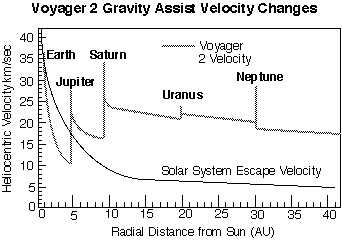Animation: Orbit to Saturn
Cassini-Huygens was launched on a Titan IV-B/Centaur launch vehicle on 15 October 1997. It is a massive spacecraft - no existing launch vehicle could have sent the 5600 kilogram craft directly to Saturn, so a technique called 'gravity assist' or 'fly-bys' was used (see the explanation of
the Slingshot effect and also the "Double ball drop" example).
Gravity assist manoeuvres work because of the mutual gravitational pull between a moving planet and a spacecraft. The planet pulls on the spacecraft as it is flying past, but the spacecraft's own mass also pulls on the planet. This permits an exchange of energy.
Cassini-Huygens looped around the Sun twice. On the first loop it flew close behind Venus in its solar orbit, where it 'stole' some of the planet's orbital momentum on 26 April 1998.
Cassini-Huygens swings by Earth and accelerates towards Saturn
The next orbit provided a second fly-by of Venus on 24 June 1999, and one of Earth on 18 August 1999. Given these three gravity assist boosts, Cassini-Huygens finally had enough orbital momentum to reach the outer Solar System.
One last gravity assist manoeuvre from Jupiter on 30 December 2000 gave Cassini-Huygens the final thrust of energy it needed to project itself all the way to Saturn. The mission arrived at Saturn in July 2004.
The Cassini-Huygens mission is a cooperative project of NASA, the European Space Agency (ESA) and the Italian Space Agency (ASI).
Credit: ESA, NASA and ASI

Voyager 2 slingshots: At each passage near a planet of our solar system, the spacecraft's velocity increased by up to ΔV ≈ 17 km/s (= 61'200 km/h).
Credit: NASA
